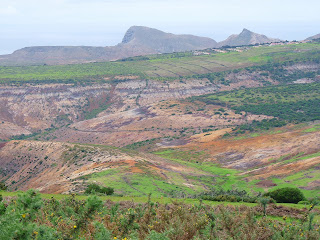 |
| 1519, St. Helena, Atlas Nautique du Monde, Biblioteheque National de France |
The genesis of this post was the page in the Maps and Views section of Barry Weaver’s St Helena Virtual Library and Archive illustrated by a part of Jansson’s 1646 map “Mar di Æthiopia Vulgo Oceanus Æthiopicus which describes the appearance, on early maps, of the mythical islands of New St. Helena and St. Matthew. It can be accessed here: http://www.bweaver.nom.sh/maps/jansson.htm
As he suggests: “the mislocation of islands was inevitable given the large navigational errors common in the sixteenth and seventeenth centuries, but once added to sea charts such islands proved extremely resilient, even in spite of a lack of any further evidence to support their existence.”
1547,Vallard Atlas, St. Matthew and St. Helena, South Orientation
Click on images to enlarge
Click on images to enlarge
1554, Gastaldi, St. Matthew and St. Helena, South Orientation
1570, Ortelius, St. Matthew
1596, Linschoten, St. Matthew and St. Helena
In 1656 Peter Mundy refers to St Matthew Island when writing about Ascension:
Soe now againe concerning the Ascention birds allsoe, thatt can neither fly nor swymme. The iland beeing aboutt 300 leagues from the coast of Guinnea and 160 leagues from the iland of St Matheo, the nearest land to it, the question is, how they shold bee generated, whither created there from the beginning, or thatt the earth produceth them of its owne accord, as mice, serpentts, flies, wormes, etts, insects, or whither the nature of the earth and climate have alltred the shape and nature of some other foule into this, I leave it to the learned to dispute of.
By 1634, in addition to St. Matthew, a second St. Helena started to appear on Maps and Charts.
1634, Guerard, Carte Universelle Hydrographique, Biblioteque National de France
1664, Du Val, I Ste Helene la nouvelle
1689, Coronelli
Though admitting that the New Isle of St Helena was thought by many to be legendary, St. Matthew is described as having a small lake of good fresh water and that it was discovered in 1526.
1706, Schenck
1717, Nicholas de Fer
1722, Nicholas de Fer
De Fer repeats the same information about St. Matthew as the 1689 Coronelli map
On his second voyage Cook sailed on “Resolution” from St. Helena on the 21st May 1775. On the 31st May he left Ascension and “steered to the northward with a fine gale at S. E. by E.” “I had a great desire to visit the island of St. Matthew, to settle its situation; but as I found the wind would not let me fetch it, I steered for the island of Fernando de Noronha, on the coast of Brazil in order to determine its longitude, as I could not find this had yet been done. Carrying on board Kendall’s KI chronometer "Resolution" was the first survey ship to carry such an instrument and had St Matthew existed would have been charted with some accuracy.
Purdy's 1814 "Tables of the observed positions of the principal points and places on the coasts of the Atlantic, Ethiopic and Indian Oceans" casts doubt on the existence of St. Matthew:
"We are told, by several historic geographers, that St. Matthew is an island discovered by the Portuguese, in the year 1516, by whom it was afterwards planted; and that vessels frequently stop here some days to take in refreshments. Guthrie says (Edition of 1783) the Portuguese " planted and kept possession of it for some time; but afterwards deserted it. This island now remains uninhabited, having little to invite other nations to settle there, except a small lake of fresh water."
"We think it not improbable that this island, like the Land of Bus, in the Northern Ocean, may have entirely disappeared. Archihald Dalzel, Governor of Cape Coast Castle, sought for it, without success, in 1799 and 1802, and it appears almost certain, from his routes, between 1 and 2 degrees South, longitude, 3 to 10° W. that it does not exist within this space. "Mr. Dalzel has made many enquiries among the Portuguese about this island, without meeting with any person who pretended to have seen it, except one, who gave him a rough draught of it, which was laughed at by the other Brasilians, who said he must have been deceived by a cloud."
It did, however, still appear on the 1828 German map below.




















